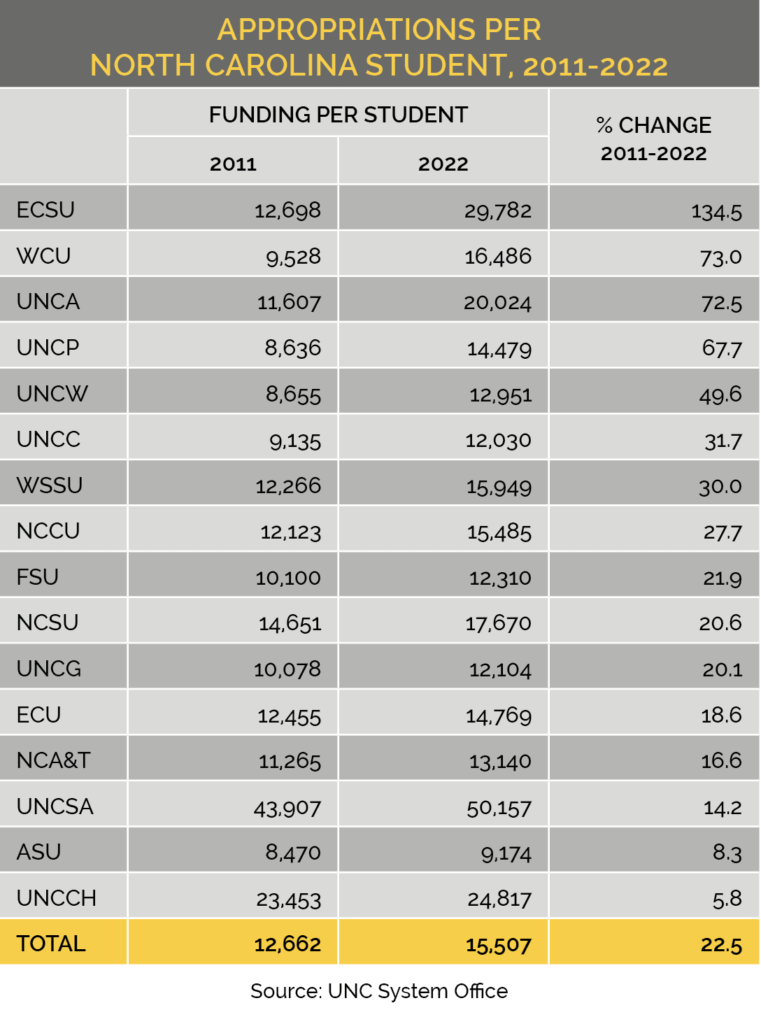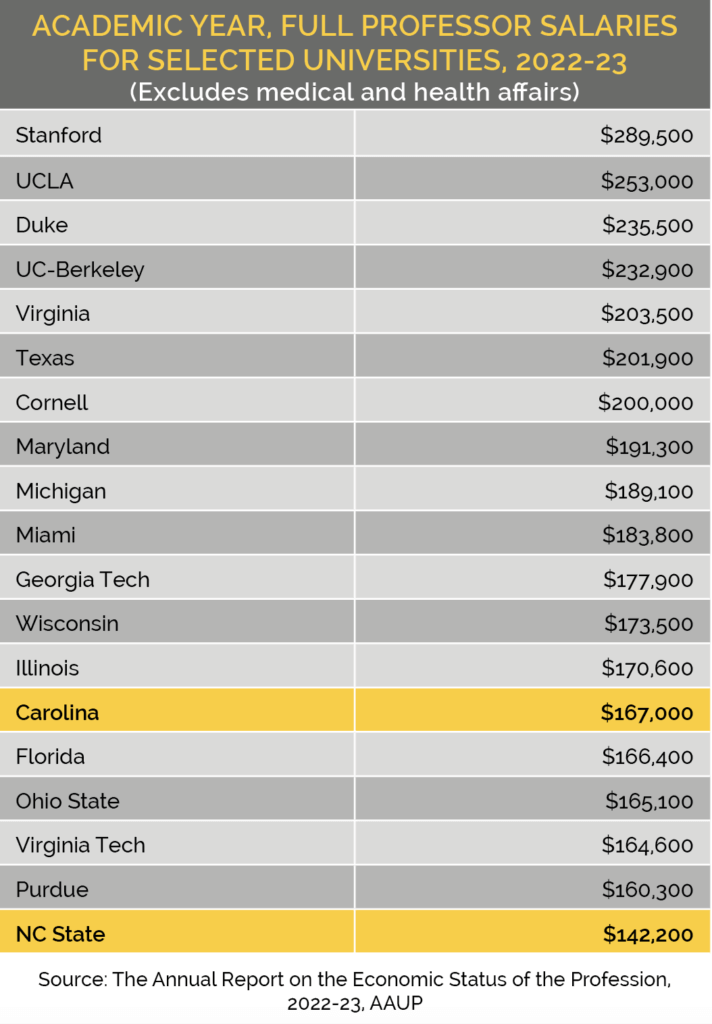You can't buy excellence, but you must pay for it
Published October 5, 2023
Written by Art Padilla
The UNC System announced recently that tuition at the 16 campuses has not changed in eight years. In no small part, this reflects the deep affection North Carolinians have for their universities.
At the same time, several Board of Governors members expressed concern about the full cost of attendance that students must pay and, more generally, about the broad adequacy of educational resources.
While tuition has remained flat—and even declined at four campuses with serious enrollment shortfalls (the so-called NC Promise institutions, where tuition has been reduced to $1,000 a year)—some non-academic student fees remain forbiddingly high. In the case of these four perennially under-enrolled campuses, for example, the fee for intercollegiate athletics, one of a dozen compulsory student fees, is nearly equal to the $1,000 tuition.
State appropriations per North Carolina student
Concern about resource adequacy is even more pertinent. Between 2011 and 2022, the Consumer Price Index rose by 30%. But in spite of massive North Carolina budget surpluses, state appropriations per North Carolina student across the UNC System increased by only 22%. Much of the 22% “increase,” which in real dollars represents a 6% decline, has come since 2020, corresponding to a period of federal “stimulus” spending due to the COVID pandemic.
These per capita funding numbers reflect differences in program costs, degree levels, and economies and diseconomies of scale. But as the chart below shows, the overall 22% increase conceals breathtaking differences by institution, from a high of 134% for Elizabeth City State to a low of 6% at UNC-Chapel Hill.
The four NC Promise institutions had an increase in per capita funding of 74%, over three times the overall increase of 22%. The five largest campuses (NC State, Carolina, Charlotte, East Carolina, and Appalachian State), which enroll nearly two of every three UNC system students, had a 17% increase in per student appropriations.

Several things are notable. First, there has been a clear redistribution, a sort of leveling, of state resources across the UNC system. Second, Appalachian State’s low amounts of absolute and relative per student funding are unexpected, considering Appalachian’s mix of academic programs and degree levels. Finally, increases in per student funding at a number of campuses such as NC State, East Carolina, NC A&T, but especially Appalachian State and Carolina, have not come close to keeping up with inflation.
Carolina is in a category all its own: its funding per student has declined 19% in real terms since 2011.
Relative salaries of the UNC flagships
Carolina’s and NC State’s funding trends have predictably led to increasingly noncompetitive professorial salaries at the two flagships. On the other hand, top administrative salaries (and bonuses) across the UNC system and the nation have managed to keep up with the cost of living.
As recently as the 1990s, full professor salaries – full professors are the most senior and highest ranking faculty members – at NC State and Carolina were similar to or, in many instances, higher than those of faculty at their private and public peers across the nation as well as those of many members of the Association of American Universities (AAU).
However, data from annual AAUP salary surveys confirm this is no longer the case. Professor salaries at public and private peer institutions, including all nine University of California campuses and the eight Ivy League institutions, now are tens of thousands of dollars higher than those at Carolina and even more so at NC State, where average salaries have fallen behind Carolina’s by $25,000 annually. (The pay advantage that Carolina has developed over NC State may be a result, in part, of the larger number of endowed professorships at Chapel Hill).

Moreover, peer universities that had comparable or slightly higher salaries in the 1990s, like UC-Berkeley, Maryland, and Virginia, have widened their advantages. Other universities that previously had lower faculty salaries than those of the two UNC system flagships, like Florida, Georgia Tech, and Illinois, have now caught or passed them.
The great universities in other states have evidently dealt with economic tribulations and political spasms better than have the ones in North Carolina.
Nothing stays the same
Alas, some decision-makers in North Carolina could care less about Carolina or NC State faculty salaries, even when those salaries are pivotal in attracting the best scholars in the world and in influencing career directions of our brightest young people.
It’s difficult to imagine a scenario that would turn this road; North Carolina has competing needs and plentiful claimants. But whatever progress and opportunities we enjoy today reflect decisions made 30 or even 50 years ago. What we do now will define our state for decades.
Some believe that Carolina and NC State have been running on fumes. This may be an exaggeration. Both universities are splendid, though quite different, institutions of international renown that still attract superb professors and terrific students.
Yet, given the financial predicaments confronting two of North Carolina’s most cherished assets, there are surely more productive ways to spend a billion tax dollars than on dubious, unproven, and nontransparent initiatives like NCInnovation and moving the UNC System headquarters from Chapel Hill to downtown Raleigh for no apparent reason other than for political control.
It’s also beyond time to reconsider the value and purpose of the UNC system.
I’m reminded of what a friend at Princeton once told me: You can’t buy excellence, but you do have to pay for it. Colorful football coach Lou Holtz put it more directly: Nothing stays the same; you either get better or you get worse.
Dr. Art Padilla splits his time between homes in Wrightsville Beach and Raleigh. He served as a senior administrator at the University of North Carolina System headquarters and later at NC State, where he was chairman of the Department of Management. He has taught at UNC-Chapel Hill, NC State, and the University of Arizona, winning several teaching awards and recognitions, including the Holladay Medal, the highest faculty honor at NC State. He recently completed the 2nd edition of his book Leadership: Leaders, Followers, Environments.







